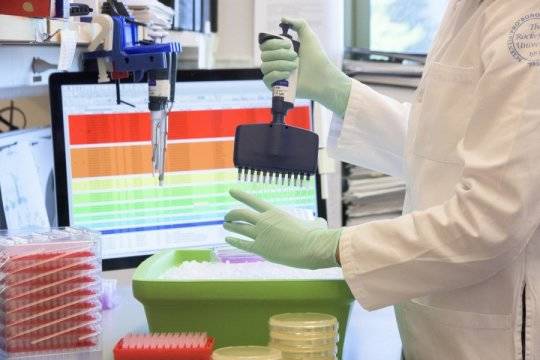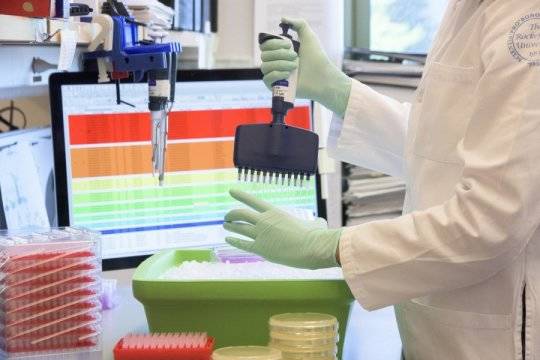실험들은 HIV와 싸우는 특별한 종류의 항체들을 발달시키기 위해서 단계적으로 면역 반응을 안내할 수 있다고 제시하고 있다.
요약: 과학자들은 한동안 각각 면역 반응의 특정한 단계에 맞춰진, 다중 면역을 이른바 광역 중화 항체인HIV와 싸우는 특별한 종류의 항체들을 만들어내는데 사용할 수 있을 것이라고 생각했다. 새로운 발견이 이 접근법을 지지하는 첫 번째 증거를 제공하고 있다.
HIV 감염을 막기 위한 비밀은 인간 면역계 안에 있지만, 지금까지 25년 이상의 탐색은 계속-변하는 바이러스를 중화시키기 위해 몸을 훈련시킬 수 있는 백신을 만드는데 실패했다. 록펠러대(Rockefeller University)와 협력 기관들에서 나온 새로운 연구는 단일 접종은 그 일을 하지 못할 것이라고 제시하고 있다. 그 대신에 이 과학자들은 순차적인 면역이 HIV 백신으로 가는 가장 전망이 밝은 길일지도 모른다는 것을 알아냈다.
과학자들은 한동안 각각 면역 반응의 특정한 단계들에 맞춰진, 다중 면역이 HIV와 싸우는 특정한 종류의 항체들, 이른바 광범위 중화 항체를 생성하는데 사용될 수 있을 것이라고 생각해왔다. 6월 18일 Cell에 실린 그 발견과 록펠러대와, 스크립스연구소(The Scripps Research Institute), 웨일코낼의대( Weill Cornell Medical College), 그리고 다른 기관들의 협동 연구의 결과는 이 접근법을 지지하는 첫 번째 증거를 제공하고 있다.
“HIV가 환자에서 돌연변이를 일으키기 때문에, 면역계는 계속해서 적응한다. 일부 환자들에서, 이 과정은 광범위 중화 항체를 만들어내는데, 이것은 광범위한 전체적으로 발생하는 HIV 변이들에 결합해서 중화시킬 수 있는 독특한 항체들이다. 이것들이 우리가 백신을 가지고 끌어내려고 하는 항체들”이라고 공동-제일저자인 록펠러대의 Michel Nussenzweig의 분자면역학 연구실에 있는 박사후 연구원인 Pia Dosenovic은 말했다. “우리의 실험들은 특정한 단계들에 맞춰진 면역을 가지고 면역 반응을 자극함으로써, 이 과정을 성공적으로 모방하는 것이 가능할지도 모른다고 제시하고 있다”고 공동 제일 저자인 Nussenzweig 연구실의 임상 조사 강사인 Lotta von Boehmer가 말했다.
HIV는 그것의 지속적인 돌연변이로 인해서, 항원이라고 불리는 외부 분자들을 인식하는 면역 단백질인 항체를 위한 표적으로 하기 어렵기 때문에 치명적인 바이러스이다. 그러나 이 바이러스의 한 부분은 돌연변이를 일으킬 수 없다: 이 바이러스가 CD5 T 세포라고 알려진 면역 세포들을 공격하는 단백질에 있는 결합 부위가 없다면 HIV가 T 세포들에 붙어서 감염시킬 수 없을 것이기 때문에 변할 수 없다. 결과적으로, 그것은 이 취약한 부분을 보호하기 위해서 그 바이러스가 하는 시도들을 극복하는 일부 광범위 중화 항체들에 의해서 표적이 되는 항원의 중요한 부분이다.
소수의 HIV 환자들은 감염의 결과로, 자연적으로 광범위 중화 항체를 발달시킨다. 다른 모든 항체들처럼, 그것들은 B 세포라고 알려진 일종의 면역 세포에 의해서 만들어지는데, 이것은 특정한 항원을 정확하게 겨냥하는 그것의 항체 능력을 개선하는 일련의 변이들을 겪는다. 독감과 같은 다른 병원균에 대항하는 항체들과 비교해서, 이 광범위 중화 항체들은 부분적으로 그것들이 엄청난 돌연변이를 겪기 때문에 구별된다. 연구자들은 그 과정의 지름길을 찾기 위해서 연구해왔지만, 지금까지 이들 광범위 중화 항체들은 백신을 가지고 끌어내기가 어려웠다.
그러나, 백신 하나는 실패한 곳에서, 아마도 두 개나 더 이상의 백신이 성공할 수도 있다. 록펠러대 연구팀은 중요한 HIV 항원의 두 가지 변이들이 HIV에 대한 면역계의 최기 반응의 진행에서 초기에 또는 그 과정 동안 나중에 투여했을 때, 어떻게 B 세포의 반응에 영향을 주는지를 시험했다. 이 연구는 인간의 항체들을 닮은 항체들을 생산하도록 유전적으로 변형된 쥐들에서 수행되었다. 이 쥐의 한 집단은 HIV를 표적으로 하는 돌연변이들을 가지지 않은 항체들을 가졌다; 이들은 감염의 초기 단계들에서 B 세포 반응을 나타냈다. 다른 쥐들에 의해서 발현된 항체들은 광범위 중화 항체의 발달과 연관된 돌연변이들을 포함했고 그래서 감염의 더 나중 단계에서 나타났다.
각각의 시나리오를 위해서 그들은 두 가지 종류의 항원들을 시험했다. 첫 번째, 중요한 CD4 결합 부위가 쉽게 접근가능하게 만들어진 항원은 스크립스연구소의 William Schief와 동료들이 만든 것이다. 코넬 웨일의대의 Rogier Sanders와 John Moore가 고안한 두 번째는 HIV에서 발견되는 자연적인 버전을 매우 닮았다.
초기 단계 시나리오를 위해서, 이 유전자조작된 항원은 항체를 생산하는 B 세포들이 광범위 중화 항체의 생산을 향한 예비 단계를 보여주는 중요한 특징들을 가진 항원들을 증식하고 만들도록 촉진함으로써 전망을 보여주었다. 반면에, 보다 자연적인 항원은 나중에 더 효과적이어서, 그 쥐들이 수많은 다른 HIV 종들을 중화할 수 있는 항체들을 생산하게 했다. “ 조작된 항원은 쥐의 혼성 면역계가 그 반응을 시작하는 것을 가능하게 해주었다. 그러나, 더 자연적인 항원이 항체들을 미세조정하는데 더 낫다”고 von Boehmer는 말했다.
그 의미는 특정한 시점에 특이적으로 맞춰진 항원들을 전달함으로써, 몸의 자연적인 면역 반응을 광범위 중화 항체를 발달시키는 과정을 통해서 단계적으로 안내할 수 있다는 것이다.
“우리의 결과는 순차적인 면역이 HIV에 대항하는 백신을 만드는 것을 가능하게 할지도 모른다고 제시하고 있지만, 우리는이 서열이 어떻게 작용하는지를 겨우 이해하기 시작했다”고 Dosenovic은 말했다. “우리는시작과 끝을 알지만, 그 중간에 무엇이 일어나야 하는지는 모른다”고 Dosenovic은 덧붙였다.
이 연구는 Howard Hughes Medical Institute 조사원이고 록펠러대학병원(RockefellerUniversity Hospital)의 선임 의사이며 Zanvil A. Cohn and Ralph M. Steinman 교수인 Nussenzweig와 스크립스연구소의 교수이며 스크립스연구소에 있는 국제 AIDS 백신 계획 중화 항체를 위한 백신 디자인센터(Vaccine Design of theInternational AIDS Vaccine Initiative Neutralizing Antibody Center)의 책임자인 Schief가 이끌었다.
6월 18일 Science에 실린 두 논문들에서, 이 연구에서 사용된 항원들을 만들었던 연구자들은 백신에서의 잠재적인 사용을 위해서 그것들을 개별적으로 시험했다. 스크립스에 있는 Schief의 연구실에서 만든 조작된 항원을 가지고, 이 팀은 그들이 HIV 감염을 인지하고 억제하기 위해서 필요한 특징들 중 일부를 가진 항체 “전구체”의 생산을 유도할 수 있다는 것을 발견했다. 그 Cell 논문처럼, 이 연구는 그 조작된 항원이 HIV에 대항하는 일련의 면역화에서 첫 번째로 좋은 후보가 될 수 있을 것이라고 제시했다. 마찬가지로, 별도의 Science 논문에서, 웨일의대의 Sanders와 그의 동료들은 백신을 향한 중요한 첫 번째 단계인, 이 바이러스의 단일 종에 대항하는 항체들의 생산 유도하기 위해서 자연적인 항원을 사용하는 것을 기술했다.
그림. 항-HIV 광범위 중화 항체의 생산을 향해서 면역계를 안내하기 위해서 고안된 실험들의 일부로서, 연구자들이 그 바이러스를 모방하기 위해서 고안된 두 가지 구별되는 항원들, 즉 외부 단백질들에 대한 그것의 반응을 조사했다. 위, 이들 항원들 중의 하나에 노출된 쥐로부터 나온 항체 서열이 색에 의해서 집단을 이루고 있다.
Journal References:
1. Pia Dosenovic, Lotta von Boehmer, Amelia Escolano, Joseph Jardine, Natalia T. Freund, Alexander D. Gitlin, Andrew T. McGuire, Daniel W. Kulp, Thiago Oliveira, Louise Scharf, John Pietzsch, Matthew D. Gray, Albert Cupo, Marit J. van Gils, Kai-Hui Yao, Cassie Liu, Anna Gazumyan, Michael S. Seaman, Pamela J. Björkman, Rogier W. Sanders, John P. Moore, Leonidas Stamatatos, William R. Schief, Michel C. Nussenzweig.Immunization for HIV-1 Broadly Neutralizing Antibodies in Human Ig Knockin Mice. Cell, 2015; 161 (7): 1505 DOI: 10.1016/j.cell.2015.06.003
2. JG Jardine et al. Priming a broadly neutralizing antibody response to HIV using a germline-targeting immunogen. Science, 2015 DOI:10.1126/science.aac5894
3. RW Sanders et al. HIV-1 neutralizing antibodies induced by native-like envelope trimers. Science, 2015 DOI: 10.1126/science.aac4223
Sequential immunizations could be the key to HIV vaccine
The immune response could be guided, stepwise, to develop a special class of HIV-fighting antibodies, experiments suggest
As part of experiments intended to guide the immune system toward the production of anti-HIV broadly neutralizing antibodies, researchers examined its response to two distinct antigens, or foreign proteins, designed to mimic the virus. Above, the antibody sequences from mice exposed to one of these antigens are grouped by color.
Credit: Zach Veilleux / The Rockefeller University
The secret to preventing HIV infection lies within the human immune system, but the more-than-25-year search has so far failed to yield a vaccine capable of training the body to neutralize the ever-changing virus. New research from The Rockefeller University, and collaborating institutions, suggests no single shot will ever do the trick. Instead, the scientists find, a sequence of immunizations might be the most promising route to an HIV vaccine.
Scientists have thought for some time that multiple immunizations, each tailored to specific stages of the immune response, could be used to generate a special class of HIV-fighting antibodies, so-called broadly neutralizing antibodies. The findings, published June 18 in Cell and the result of a collaborative effort by Rockefeller, The Scripps Research Institute, Weill Cornell Medical College, and other institutions, provide the first evidence supporting this approach.
"As HIV mutates in a patient, the immune system continually adapts. In some patients, this process produces broadly neutralizing antibodies, which are unusual antibodies that can bind to and neutralize a wide range of globally occurring HIV variants. These are the antibodies we want to try to elicit with a vaccine," says co-first author Pia Dosenovic, a postdoctoral fellow in Michel Nussenzweig's Laboratory of Molecular Immunology at Rockefeller.
"Our experiments suggest that by stimulating the immune response with tailored immunizations at specific stages, it may be possible to successfully mimic this process," says co-first author Lotta von Boehmer, an instructor in clinical investigation also in Nussenzweig's lab.
HIV is a pernicious virus precisely because its continual mutations make it a difficult target for antibodies, immune proteins that recognize foreign molecules called antigens. But one part of the virus cannot mutate: the binding site on the spike protein with which the virus attacks immune cells known as CD4 T cells. This part of the virus can't change because without it, HIV would not be able to attach to and infect the T cells. As a result, it is a key part of the antigen targeted by some broadly neutralizing antibodies, which overcome attempts by the virus to protect this vulnerable site.
A small number of HIV patients develop broadly neutralizing antibodies naturally, as a result of infection. Like all other antibodies, they are produced by a type of immune cell, known as a B cell, which undergoes rounds of mutations that refine its antibodies' ability to precisely target a specific antigen. As compared with antibodies against other pathogens, such as flu, these broadly neutralizing antibodies are distinctive, in part because they have undergone a great deal of mutation. Researchers have been working to find a shortcut to the process, but so far these broadly neutralizing antibodies have proven difficult to elicit with a vaccine.
But where one vaccine has failed, perhaps two or more can succeed. The Rockefeller research team tested how two variations of the crucial HIV antigen affected the B cells' response when administered either early in the progression of the immune system's initial response to HIV, or later during the process. The work was conducted in mice genetically engineered to produce antibodies resembling those of humans.
One group of mice had antibodies with no HIV-targeting mutations; these represented a B cell response during the early stages of infection. The antibodies expressed by the other mice contained mutations associated with the development of broadly neutralizing antibodies, and so stood in for a later stage of infection.
For each scenario, they tested both types of antigens. The first, an antigen engineered to make the crucial CD4 binding site easily accessible, was made by William Schief and colleagues at Scripps. The second, designed by John Moore and Rogier Sanders at Weill Cornell, closely resembled the natural version found in HIV.
For the early-stage scenario, the engineered antigen showed promise by prompting the antibody-producing B cells to proliferate and produce antibodies with key traits representing a preliminary step toward the production of broadly neutralizing antibodies. Meanwhile, the more natural antigen was more effective later on, inciting the mice to produce antibodies capable of neutralizing a number of different HIV strains.
"The engineered antigen made it possible for the mice's hybrid immune system to get the response started. However, the more natural antigen is better at fine tuning the antibodies," von Boehmer says.
The implication is that by delivering specifically tailored antigens at specific times, the body's natural immune response can be guided, stepwise, through the process of developing broadly neutralizing antibodies.
"While our results suggest sequential immunizations may make it possible to vaccinate against HIV, we have only just begun to understand how this sequence would work," Dosenovic says. "We know the beginning and the end, but we don't know what should happen in the middle."
This research was led by Nussenzweig, Zanvil A. Cohn and Ralph M. Steinman Professor, a senior physician at The Rockefeller University Hospital and a Howard Hughes Medical Institute investigator, and Schief, a professor at The Scripps Research Institute and director, Vaccine Design of the International AIDS Vaccine Initiative Neutralizing Antibody Center at Scripps..
In two papers published June 18 in Science, the researchers who generated the antigens used in this study tested them individually for potential use in vaccines. With the engineered antigen made in Schief's lab at Scripps, this team found they could induce the production of antibody "precursors" with some of the traits necessary to recognize and block HIV infection. Like the Cell paper, this study suggests the engineered antigen could be a good candidate as the first in a series of immunizations against HIV. Likewise, in a separate Science paper, Sanders, at Weill Cornell, and his colleagues describe using the native antigens to induce the production of antibodies against a single strain of the virus, an important first step toward a vaccine.



